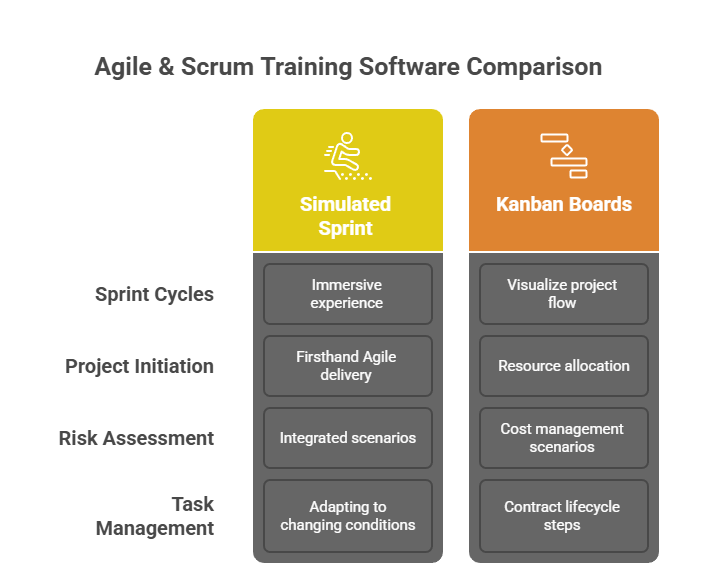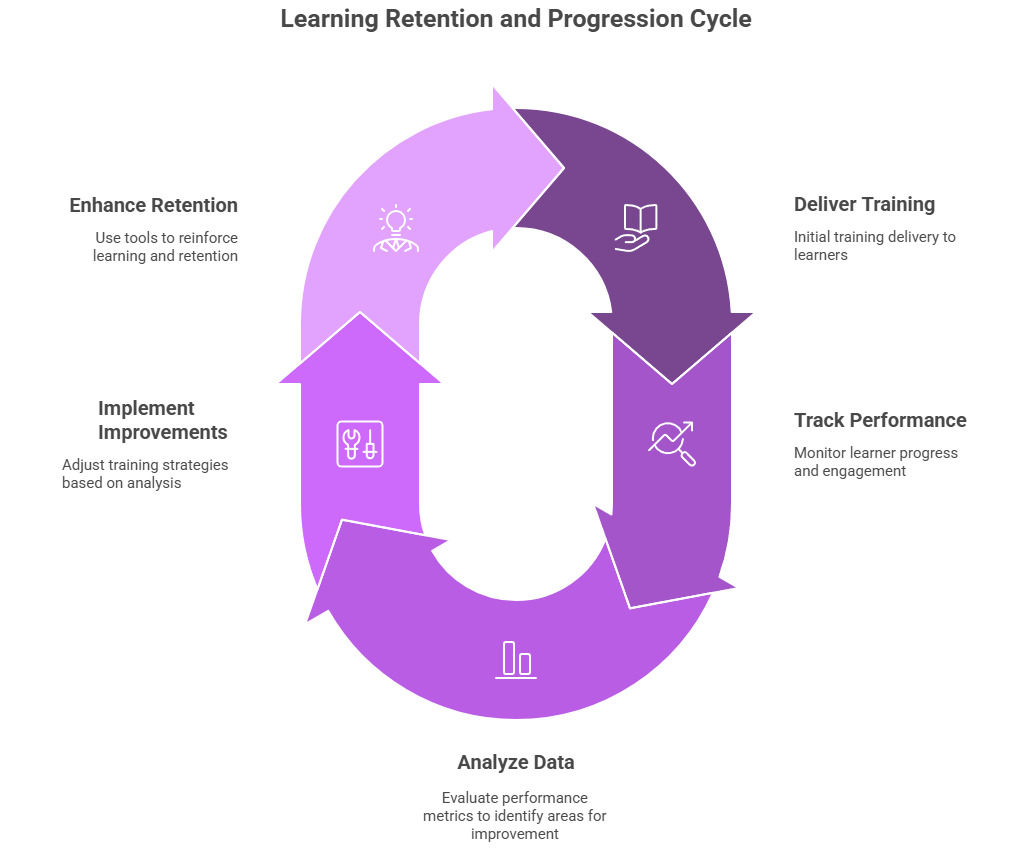Best Software Platforms for Project Management Training
Project management training has evolved now driven by digital platforms that replicate real-world scenarios and agile workflows. These tools help learners grasp everything from scrum roles and responsibilities to dynamic project lifecycles without needing a live team. Whether you’re preparing for certification or brushing up on fundamentals, software-based training brings unmatched accessibility and structure.
Modern training platforms now include interactive dashboards, visual timelines, and terminology references aligned with global standards. Learners can explore the top 100 project management terms while gaining hands-on experience through simulations and collaborative modules. These tools not only increase retention they help build confidence in managing deadlines, teams, and deliverables in any industry.
What to Look for in PM Training Software
Choosing the right software platform for project management training isn’t just about convenience it’s about transforming how professionals internalize complex concepts. In 2025, the most effective training tools offer hands-on, immersive experiences that mimic real-world project challenges. From interactive dashboards to agile sprint simulations, every detail matters.
High-quality platforms should offer interactive Gantt chart modules, allowing learners to visualize timelines, float, and dependencies. These visuals help build intuition around sequencing, delay management, and resource leveling. Tools that integrate agile workflows, Kanban task flows, and burndown tracking also offer deep value, especially for professionals working in fast-moving, iterative environments.
For those targeting certifications or high-stakes roles, it's vital that platforms align with globally recognized frameworks like PMBOK® and Six Sigma. These systems help ensure standard terminology, structure, and assessment consistency. Some platforms even break down project scenarios using a comprehensive risk management glossary enabling learners to identify, assess, and respond to project threats in real time.
Scenario-based learning is another hallmark of elite training platforms. These modules simulate cost overruns, scope creep, team conflicts, or contract breakdowns empowering learners to make decisions, see consequences, and iterate safely. Platforms that offer live feedback, peer grading, or instructor-led debriefs take the learning even further.
Moreover, integration features play a growing role. Top platforms allow learners to connect tools like Slack, JIRA, or Trello making the training environment mirror the actual workplace. This means trainees not only learn theory but also how to execute it using the tools their teams already rely on.
In short, the best software for project management training doesn't just teach; it immerses, challenges, and transforms learners building professionals who are job-ready from day one.
What Makes PM Training Software Truly Transformative
Modern project management training platforms aren't just digital classrooms — they're immersive ecosystems. The best software offers hands-on simulations that replicate real project scenarios, from sprint breakdowns to stakeholder escalations.
Look for tools that include interactive Gantt charts, agile board modules, and burndown tracking — all tied to live projects or simulated tasks. These features build true execution fluency, not just memorization.
Want certification alignment? Top-tier systems follow frameworks like PMBOK®, Six Sigma, and PRINCE2, making them ideal for CAPM®, PMP®, or Lean Six Sigma prep.
Even better: the best platforms integrate tools you already use — think Slack, Trello, or JIRA — creating a seamless bridge between training and the real workplace.
It’s not just about learning project management — it’s about learning how to manage projects in the tools, frameworks, and pressure zones of your actual job.
Best Software for Agile & Scrum-Based Training
Simulated Sprint Environments
Effective Agile training platforms do more than outline concepts — they immerse learners in simulated sprint cycles where they can plan, execute, and retrospect. These tools recreate user stories, sprint backlogs, daily stand-ups, and burndown charts to help trainees experience Agile delivery firsthand. It’s especially useful for those learning project initiation principles and iterative development models.
Some simulations include real-time blockers, shifting stakeholder input, and evolving requirements — just like real Agile projects. This dynamic approach gives learners confidence in adapting to changing conditions. Moreover, integrated scenarios help build competency in risk identification and assessment — a crucial part of any Agile sprint review or backlog grooming session.
Kanban Boards & Task Flows
Visual task management is critical in Agile and Lean environments. Platforms that use Kanban boards to teach workflow prioritization, limit work-in-progress (WIP), and manage bottlenecks offer immense training value. These systems help learners visualize project flow from backlog to delivery.
Key features include drag-and-drop task cards, priority flags, and progress tracking metrics. Trainees can experiment with changing workflows, allocating tasks, and tracking performance under constraints. It builds intuitive understanding of resource allocation and task sequencing.
To support financial awareness in Agile, some platforms tie these boards into cost management scenarios — showing how task overruns affect budgets. Others integrate procurement simulations, helping learners get familiar with contract lifecycle steps while managing multiple vendors and approvals.
Top Platforms for Soft Skill Development
Project management isn't just about tasks and timelines it’s about navigating human dynamics. The best training platforms include interactive simulations that challenge learners to manage team conflicts, lead stakeholder meetings, and resolve priority clashes under pressure. These platforms allow PMs to test emotional intelligence, communication clarity, and decision-making.
Role-play modules train project managers to handle HR challenges, mediate disputes, and manage team morale. Tools with behavioral branching scenarios let learners experience the impact of various decisions from ignoring a red flag to over-asserting authority. These simulations also strengthen understanding of HR responsibilities in project teams.
Many platforms reinforce learning with modules rooted in team-building terminology encouraging soft-skill mastery alongside traditional project execution.
| Platform | Key Soft Skill Features | Best For |
|---|---|---|
| SimulationHub PM | Interactive team conflict resolution, branching scenarios, emotional response grading | Mid-level PMs improving conflict management |
| SkillBuilder360 | Live stakeholder meeting role-plays, leadership feedback, soft skill scoring | Aspiring team leads and PMs seeking promotion |
| EmpathIQ Sim | Emotional intelligence drills, HR dispute simulations, tone calibration tools | Project managers in client-facing roles |
| CollabCore PM Lab | Team morale monitoring, situational decision trees, team-building glossary integration | Agile teams and distributed team leads |
| LeadEdge Interactive | Soft skill KPIs, real-time peer feedback, behavioral impact heatmaps | PMs in matrix or cross-functional teams |
Best Tools for Financial & Budgeting Skills Training
Understanding costs, budgets, and contracts is foundational for every PM. The most robust platforms offer budgeting calculators, variance simulations, and cost forecast tools to help learners understand how small overruns can snowball. PMs get hands-on with change order approvals, baseline comparisons, and financial KPIs.
Budget-focused platforms help learners simulate end-to-end financial planning — from initial estimates to final reconciliations. Scenario-based training modules simulate mid-project funding cuts or scope changes and test users’ ability to rebalance timelines and cash flows.
Some tools are directly aligned with budgeting terminology while others integrate case studies around contract terms, deliverables, and payment milestones.
Why These Tools Elevate Budgeting Mastery
The best financial training tools go far beyond static spreadsheets — they simulate real project pressures like cost overruns, funding gaps, and shifting deliverables. This isn’t theory — it’s interactive decision-making based on contracts, KPIs, and scope shifts.
What sets top platforms apart is their ability to combine calculators, approval chains, and scenario planning within one environment. Trainees aren’t just crunching numbers — they’re learning to react like real financial gatekeepers.
Whether you’re adjusting cash flow forecasts or analyzing baseline variances mid-project, these tools build fluency in the financial reality of project management.
Interactive Learning with Gantt, CPM, and Scheduling Tools
Theoretical knowledge is not enough in project management — real learning happens through simulation. The best training platforms feature Gantt chart simulators, Critical Path Method (CPM) modules, and timeline visualizers that allow project managers to manipulate dependencies, deadlines, and float in real-time.
By adjusting task durations or resource assignments, learners immediately see the cascading effects of delay, resource bottlenecks, or task overlaps. These hands-on modules foster deep comprehension of project scheduling mechanics, teaching users how to optimize timelines under scope, cost, and team constraints.
Some platforms directly integrate tools reviewed in the top scheduling software guide, while others offer sandbox Gantt environments similar to those seen in the leading chart software solutions.
Which scheduling tool simulation helps you learn best?
Reporting, Analytics & Knowledge Retention Tools
Effective training platforms don’t stop at delivery — they help track how well learners absorb concepts. Reporting dashboards, real-time analytics, and in-course quizzes allow PMs to measure their strengths and pinpoint weak areas. Some tools feature simulated portfolio reviews or post-project analysis to deepen concept retention.
Advanced systems generate performance reports that highlight completion rates, knowledge gaps, and average response times — ideal for corporate training teams or individuals preparing for certification. This supports long-term learning retention and progression tracking.
Some platforms incorporate tools also found in contract lifecycle software or simulate structured document workflows using systems highlighted in the best document management software article — blending learning and operational realism.
Final Thoughts
The right project management training software doesn’t just teach theory — it builds decision-making confidence, sharpens execution under pressure, and reinforces every core skill a PM needs. Whether your focus is agile sprints, stakeholder engagement, or cost control, today’s tools offer hands-on training environments that simulate real-life complexity.
From entry-level learners to seasoned professionals prepping for certification, effective platforms turn learning into a repeatable, measurable process. Many integrate essential frameworks covered in project communication strategy guides, helping users develop both technical and soft skills in one streamlined experience.
With the right software stack, project managers stay competitive — not just informed.
Frequently Asked Questions
-
Agile-focused tools like Jira, ClickUp, and Monday.com offer interactive sprint planning, backlog refinement, and real-time collaboration. These platforms simulate agile workflows, helping learners understand iterative planning and team velocity. For comprehensive learning, platforms should include built-in guidance on agile principles, user stories, and sprint retrospectives. A great starting point is understanding project initiation terminology to get familiar with the agile process and its foundational language before diving into tools.
-
Software like Wrike, Zoho Projects, and Smartsheet include features for tracking budgets, forecasting expenses, and managing cost variance in real-time. They offer budgeting simulators, expense dashboards, and resource allocation tools. Understanding financial control in project management starts with mastering budgeting vocabulary, like burn rate and cost variance. Our complete guide to project budgeting terms offers a useful foundation before choosing the right software for financial training.
-
Yes. Platforms like SimulTrain, Miro, and TeamGuru include conflict resolution scenarios, stakeholder role-plays, and communication simulations. These tools go beyond tasks and timelines to enhance leadership, negotiation, and team-building skills. Simulations mimic real-life PM situations, helping learners practice people management. Before diving in, familiarize yourself with key interpersonal concepts from the team-building terminology guide for PMs to maximize soft skill training outcomes.
-
Many training platforms integrate PMBOK® or PMI-aligned content into their modules, such as Simplilearn, Velociteach, and GoSkills. They provide mock exams, case studies, and interactive flashcards. These tools complement exam prep by reinforcing terminology and process groups. To build a strong foundation, start by mastering essential PM terms using the Top 100 Project Management Terms You Must Know (2025 Edition) article.
-
Platforms like TeamGantt, ProjectLibre, and Lucidchart let learners work directly with timelines, dependencies, and milestones. These platforms help develop logic-based scheduling skills and highlight how delays cascade across tasks. For clarity on scheduling structures, review this guide to calendar and scheduling tools to pick software that aligns with your learning preferences and scheduling depth.



